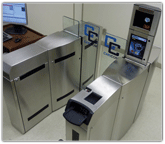Dept. of Homeland Security fills important biometrics role
08 November, 2013
category: Biometrics, Government
The Department of Homeland Security (DHS), is leveraging biometrics to remain on the cutting edge of identity verification and to better ensure the safety of the country. There are a number of agencies that process and interact with international travelers – each of whom must be identified as friend or foe.
Enter the DHS’ Office of Biometric Identity Management (OBIM), the agency that is taking the reins for biometric identification. OBIM verifies the identities of international travelers to determine whether they pose a threat to the U.S.
As reported by the Federal Times, to address Customs and Border Protection needs, OBIM’s systems have 10 seconds to verify a person’s identity and determine whether foreign travelers are one of the 7.2 million known or suspected terrorists on watch lists. Additionally, when State Department employees send fingerprint queries to OBIM for visa applicants, they do so with an expected response time of 15 minutes or less. That deadline is even tighter for Immigration and Customs Enforcement where the expected turnover is just two minutes.
A vast majority of the interactions between OBIM and outside agencies are machine-to-machine with little human interaction. In fact, agency officials estimate that 99% of total identity matches are made exclusively using OBIM systems with fingerprint examiners filling the remaining gaps.
According to OBIM’s daily biometric support system located in Arlington, VA, less than 1% of fingerprints – roughly 500 per day – are manually screened into the system.
OBIM, which previously operated under the moniker “United States Visitor and Immigration Status Indicator Technology (US-VISIT),” has since its inception amassed a database of some 160.2 million identities and it’s estimated that between 10 million and 12 million unique identities are added to the system each year. OBIM officials insist that the agency’s purpose is not to simply collect biometric data but to store, manage and analyze hundreds of thousands of fingerprints for federal, state and local governments on a daily basis.
In response to OBIM’s ever-growing IT systems and data stores, the agency is weighing its options for cloud-based storage. To assist this eventual move, OBIM has collaborated with the National Archives and Records Administration to augment the fingerprint record retention period of 75 years to better serve customer needs.
The 2013 OBIM budget was $232 million this past year – a majority of which was put toward IT operations and maintenance. This is expected to increase to $241 million budget for the 2014 fiscal year.



